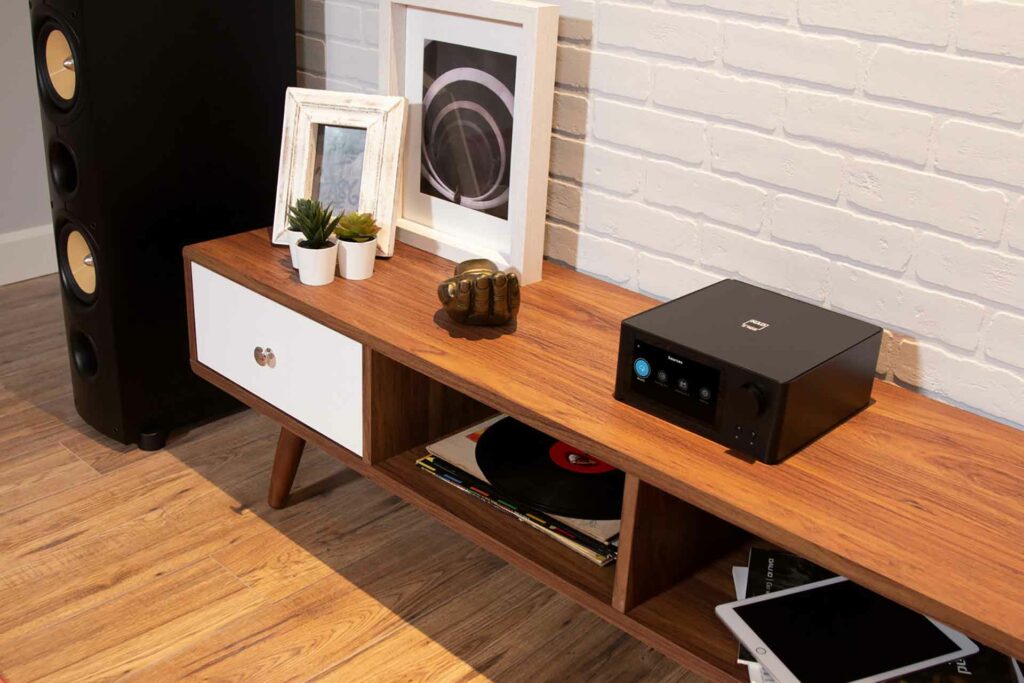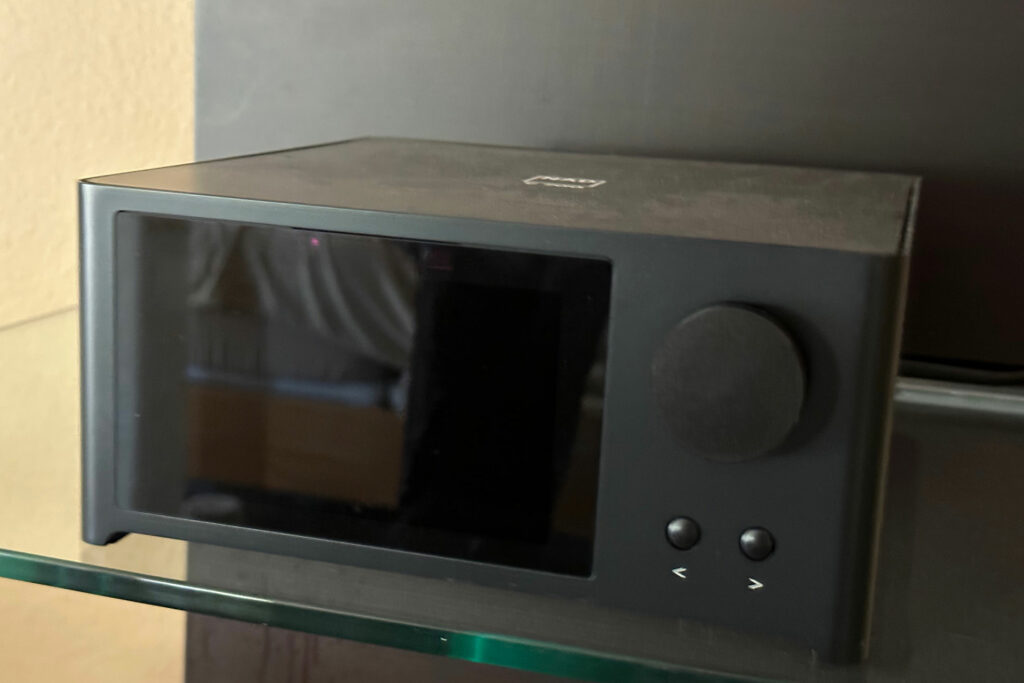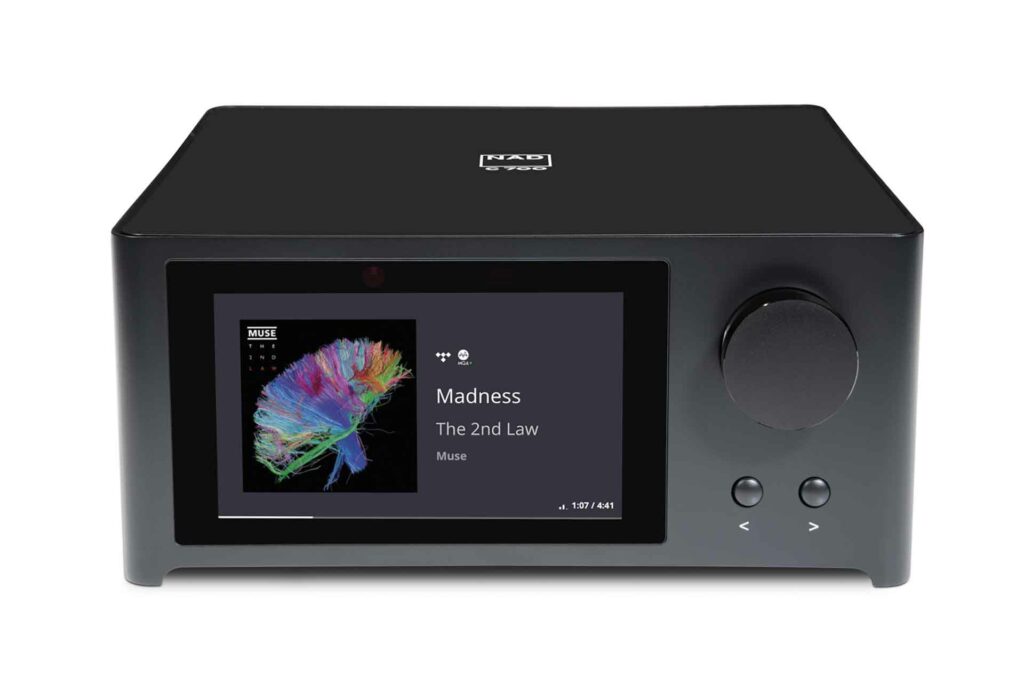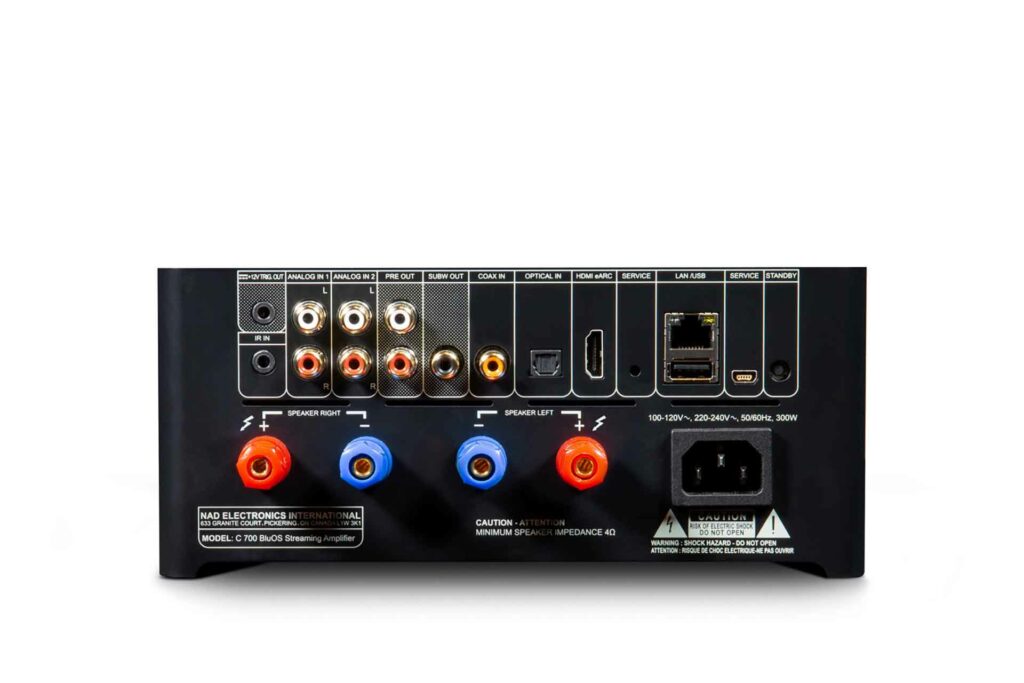NAD, an audio company well-known by enthusiasts worldwide for their high-value electronics, is part of the Lenbrook group, which also includes PSB speakers and Bluesound wireless streaming devices. The technology behind each brand is often shared within the family, as is the case with the NAD C 700 BluOS Streaming Amplifier, (buy at Crutchfield) which is the topic of this review. As part of the company’s just-add-speakers product category, the C 700 is an audiophile integrated amplifier with wired and wireless music streaming through the BluOS streaming platform and its integration of popular music streaming services, including Tidal and Spotify Connect. Additional digital and analog inputs support various other audiophile DACs and digital sources. The C 700 is loaded with many valuable features, yet comes in a compact form factor and retails for just $1,599. While that is not inexpensive, it is hard to find a competing product with the same features and flare at or near that price point.

What Makes the NAD C 700 BluOS Streaming Amplifier Special?
- The NAD C 700 BluOS streaming amplifier is a well-featured high-resolution music streamer that numerous streaming services and protocols, such as Qobuz, Amazon Music HD, Deezer, Idagio, Apple AirPlay, and Roon. Spotify Connect and Tidal Connect add another level of streaming capability by offering direct server connectivity to the NAD C 700 with the BluOS app in control and the Connect feature provided by those platforms.
- The NAD C 700 possesses an MQA decoder and renderer. Tidal is the only streaming service with an MQA library of music at the moment. The system’s efficacy is debatable and may vary by music file, but it’s worth experimenting with.
- The BluOS platform is stable and easy to use, with great functionality and connectivity.The BluOS controller app for iOS, Android, Mac OS, and Windows is intuitive and robust and can support multi-zone whole home audio with BluOS integrated powered speakers or other BluOS-capable components, including other stereo systems, as well as some AV receivers.
- The five-inch color display shows visual album cover art on streamed music, and relevant track information provides a sleek and sophisticated cool factor. The display content can be set by the front controls of the C 700 – if album art is not your thing, opt for the retro virtual VU meters with fluttering right and left amplifier output. There are a total of eight different display choices. I opted for the album art and a visual output meter.
- NAD uses its proprietary HybridDigital signal path and Hypex UcD (Universal Class D) amplifier technology, which provides 80 watts per channel of continuous power with both channels driven and 120 watts per channel of peak power for high-demand transients. 80 watts can power a lot of modern speakers these days.
- A variety of analog and digital inputs ensures thorough integration with your existing sources, including two sets of RCA analog inputs and three digital inputs: HDMI eARC, optical, and coaxial. Through the HDMI eArc input, a smart TV’s built-in apps can be easily connected as a source for the audio portion of movies or anything that can be streamed.Because of CEC via HDMI the NAD C 700 can also control your TV and your TV speakers (including mute) if so desired.
- Two subwoofer outputs with crossover control from the front panel make adding a subwoofer super simple and convenient. Equally important is that the subwoofer crossover not only diverts selectable bass frequencies to the subwoofer but also sends a high-passed signal to the main speakers. This means your main speakers are not dealing with challenging bass frequencies that smaller monitors cannot handle while relieving the C 700 amplifier from reproducing the power-hungry lower bass frequencies.
- Preamp outputs allow outboard amplification to be connected if you find yourself needing more power, however unlikely that is. A 12-volt trigger gives the C 700 on/off control for an external amp, as well. These features enable system expansion and keep the C 700 relevant longer.
Why Should You Care About the NAD C 700 BluOS Streaming Amplifier?
The NAD C 700 BluOS is a culmination of three important qualities: price point, form factor, and performance. While there are both higher- and lower-priced products with and without similar features, the NAD C 700 offers conscientious designer-oriented consumers a product that will be comfortable in a sophisticated living room for an attractive lifestyle-friendly sound system. The compact design also allows for installation in tight areas such as dorm rooms or bedrooms.

Some Things You Might Not Like About the NAD C 700 Streaming Amplifier
- The color display screen is not a touchscreen. I mention this due to the trend of this type of control being common in cars and appliances. While I appreciate touchscreens’ wow factor and sophistication, it’s not all rainbows and unicorns. My NAD M17 AV processor’s touchscreen is rarely accessed due to the organic way of interacting with the processor from my seated position on the couch through the remote – call me lazy.
- The NAD C 700 lacks a headphone output; however wireless audiophile headphones are supported with two-way aptX HD Bluetooth. If you’re an audiophile turntable enthusiast, the pack of a phono stage input might be a concern. Still, an outboard phono stage would solve the problem cheaply and easily, and some turntables have an internal phono preamp, allowing direct connection via the analog RCA inputs.

Listening To the NAD C 700 BluOS Streaming Amplifier…
I listened to many recording artists on the NAD C700 but focused on two tracks, both streamed as MQA Master recordings through Tidal Connect. With the NAD C 700 connected to a modest pair of Dali Spektor 2 bookshelf speakers, I streamed Tracy Chapman’s “Talkin’ about a Revolution” from her 1988 eponymous debut album for its acoustic instrumentation distinctive vocals, as well to hear a known quiet passage: at about sixteen seconds into the music, Tracy murmurs at low-level part of the third verse “like a whisper.” On some systems, the passage may not be noticeable, or, if it is audible, it is not coherent. The verse was easily intelligible here, though, demonstrating the sophistication of the NAD C 700. The imaging was within and just beyond the location of both left and right speakers as long as I was positioned five feet or more in front of them. A reasonable amount of depth and an accurate forward presentation added to the texture of Chapman’s voice, demonstrating a high level of clarity and realism. While I was impressed with the Dali Spektor 2s, I pushed the C 700 further to see if a full-range presentation could be achieved by connecting my Focal Kanta No. 2s. On the same song, bass extension and grip improved, along with image size, depth, and width, with a holographic presentation floating just forward of the speakers.
I was surprised by how well the C 700’s Class D amp modules commanded the Focal Kantas without stress. Since there was no sign of the NAD C 700 struggling with the Kantas, I played Peter Gabriel’s “Shock the Monkey” from his 1982 eponymous album which has a heavy percussion and bass line that runs throughout the song. The image continued to play tall and wide beyond each speaker’s location, wrapping around my seated location, with an astounding amount of bass control that belies what one would think is possible from such a physically small amplifier. However, let’s be realistic and understand the C 700 will not be the last word in amplification: typically, the Kantas are connected to a pretty fancy pair of Pass Labs XA60.8 (read the review) Class A monoblock amplifiers, delivering a vivid three-dimensional presentation with elevated warmth, brilliance, and further extended bass. Nonetheless, the NAD C 700 impressed me with its built-in amplification way beyond what I expected.
Does the NAD C 700 BluOS Streaming Amplifier Hold Its Value?
The C 700 has high usefulness; before selling, consider relegating it to another room like a bedroom or office or use it in your primary system as an attractive streamer and preamplifier with external amplification. While audio gear is not a growth investment strategy, I believe consumers will benefit from average to perhaps lower than average depreciation – your purchase price will not plummet into oblivion.

What Is the Competition for the NAD C 700 BluOS Streaming Amplifier?
This product category is heating up fast, with new products being introduced often. Let’s start with NAD’s sister brand BluOS: we have the BlueSound Powernode Edge ($649 buy at Crutchfield) and BlueSound Powernode ($959 buy at Crutchfield), rated at 40 watts and 80 watts per channel, respectively. Aside from the lower power output, the Powernode Edge uses a sophisticated amplifier technology called DirectDigital versus the more common Class D architecture of the Powernode and C 700. The benefit of DirectDigital is that on digital music streamed or stored, the technology maintains the digital pulse code modulated (PCM) signal until the very end, which is only converted to an analog signal at the speaker output stage without the need for a traditional DAC, arguably amplifying the signal more efficiently and cleanly. It is a complete surprise to me why Bluesound would implement such a technology into a lower-priced product, but the Powernode Edge is in line for review, and I look forward to putting it to the test. One drawback to both units is the lack of style or form factor: without a traditional display or any hint they are audio components, they possess the appearance of an internet router or hard drive. No one would conclude they are integrated amplifiers with streaming capability by looking at them. On the other hand, both have all the streaming capabilities of the C 700, including Tidal Connect and MQA decoding and rendering, along with the BluOS streaming platform and mobile device app providing all the control and information one would need. One of these units may be a better choice if you are looking for a lower price point than the C 700.
Another offering from NAD is the C 339 Hybrid Digital DAC amplifier at a retail price of $1,999. With a more audiophile appeal in the way of component size and proportions, along with features more important to this group of listeners, including a bump in amplifier power to 180 Watts of continuous power and 250 Watts of dynamic power, a moving magnet (MM) phono stage input, and a built-in wired headphone amplifier, allowing the C 399 to work with difficult-to-drive headphones. DAC processing power remains the same. The color screen is gone in favor of a more traditional LED display. Another design difference is the inclusion of two rear Modular Design Construction (MDC2) ports, which is NAD’s proprietary method of adding hardware, features, connectivity, and potential future-proofing to the C 399. For example, to add BluOS streaming capability and Dirac Live room correction, a module can be added at purchase or user installed later for a cost of $549, which brings the fully featured version of the C 399 to $2,548. As of this writing, another model is coming soon – the C 389 –with limited information on pricing and specifications, so it will not be discussed here but may be of interest to you when it becomes available.
At a similar price point to the C 399 is the NAD M10 V2 at $2,599, which provides all the features of the C 700 and then some. From a price point, this is a $1,400 increase, so what justifies the expense? Since this is a Master Series product, the build quality is better than the C 700, along with a larger seven-inch Gorilla Glass color display that operates as a touch screen plus a glass top panel. Another prominent feature is the included basic version of Dirac Live, which can perform room correction up to 500Hz, with the ability to upgrade to the full bandwidth version for a small $99 investment through Dirac. Another thoughtful feature is Dolby Digital processing into a 4.1 or 4.2 surround setup with the two rear channels connected wirelessly to Pulse Flex BluOS-enabled powered speakers or a Powernode (or a Powernode Edge). This allows further integration of your television from stereo to a light implementation of surround sound for movies. Also included is a more powerful amplifier rated at 100 watts of continuous power per channel with higher headroom up to 160 watts per channel into 8 Ohms or 300 watts per channel into 4 Ohms, both channels driven, with the implementation of Hypex nCore UcD modules. DAC processing power is elevated with ESS Sabre 9028 digital to analog converters. The M10 V2 also includes a remote control and higher-grade speaker terminals. The challenge with this model and others at this higher price is additional competition.
If I were to push my budget up to the $2,500 mark, the made-in-Denmark Lyngdorf TDAI 1120 would be my top consideration due to its sophisticated direct digital amplifier technology that the company is known for, coupled with its proprietary room correction and equalization system known as RoomPerfect. As with the other contenders, the TDAI 1120 can stream music from popular services, including Tidal Connect, and is also an MQA decoder and renderer.
Other higher-priced competitive units include the Rotel S14 ($2,499 buy at Crutchfield), Cambridge EVO 75 ($2,499 buy at Crutchfield), and of course, the highly acclaimed Naim Unity Atom ($3,799 buy at Amazon). All these units have similar features and streaming capabilities and in some cases the addition of room correction and surround sound. Still, the price point makes these units a concern and well beyond the cost of admission compared to the NAD C 700.

Final Thoughts on the NAD C 700 BluOS Streaming Amplifier…
As you may have noticed, Lenbrook has this category pinned down well with Bluesound and NAD, with multiple products at various price points and features – more than any other company. However, NAD C 700 BluOS Streaming Amplifier (buy at Crutchfield) strikes a compelling balance of price, performance, and form factor. As I went through the review process, I could not find a product that blends these criteria at $1,599.
I will sum this up by mentioning that my family members (wife and two children) asked individually if I could purchase the NAD C 700 when I was done reviewing it for their own personal space and use, which should provide some insight as to how intriguing this virtuous compact single unit device ignites interest and desire. If the NAD C 700 does not satisfy your auditory senses, it only means you are a higher discerning listener in need of a larger budget. Lastly, in commemorating Lenbrook’s 50th anniversary, the company created an entertaining yet educational YouTube video discussing NAD’s rich history, which I found informative and inspiring. If you would like to learn more about NAD, give it a look. In the comment section below, let me know what you think or what functionality and features are important to you in a streaming amplifier like the NAD C 700.



